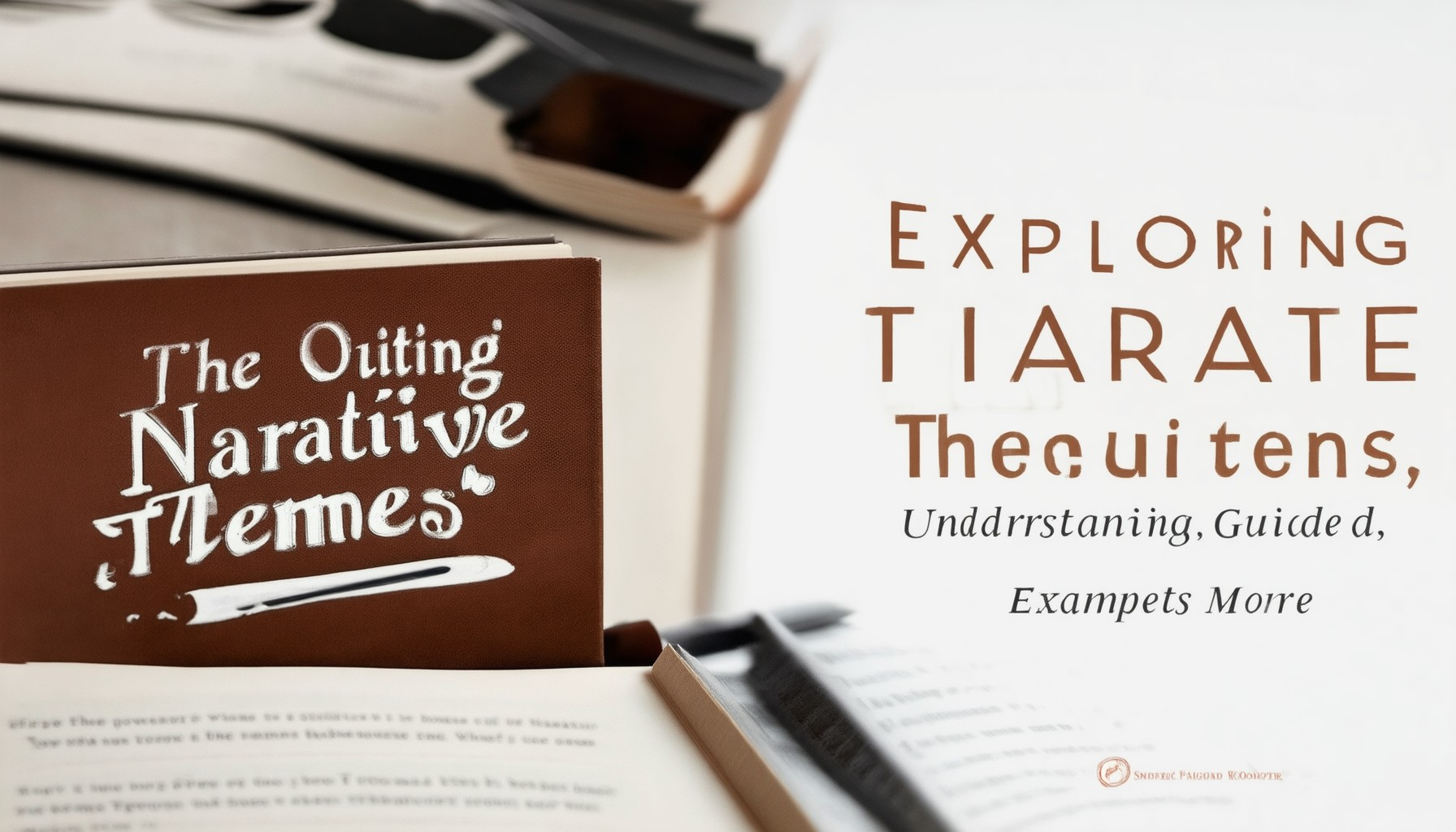Storytelling is a universal human experience, a way to connect with our emotions, cultures, and the world around us. At the heart of every compelling narrative lies the concept of **narrative themes**—those core messages that resonate deeply with readers, offering insights into the human condition and universal truths. Whether it’s the struggle for identity, the pursuit of justice, or the complexities of love, themes in literature and storytelling provide a lens through which we can better understand ourselves and the world.
Understanding narrative themes is essential for anyone who wants to craft meaningful stories, whether in literature, film, or personal reflection. These themes often emerge as the underlying threads that connect characters, plots, settings, and symbols, creating a cohesive tapestry of meaning. By exploring the elements that shape these themes, this guide will delve into the definitions, examples, and strategies for identifying and leveraging themes in your own narratives. From classic novels to modern tales, themes offer a powerful way to communicate ideas that transcend time and culture. Let’s embark on a journey to uncover the essence of narrative themes and how they can enrich your storytelling practice.
Here are the key takeaways from the article:
- Understand narrative themes to unlock the deeper meaning of stories.
Themes provide the foundation for storytelling, guiding characters and plot development.
- Identify common themes like Good vs. Evil, Coming of Age, and others in popular works.
Recognizing these themes helps readers connect with universal human experiences.
- Strong themes drive storytelling, providing clarity and emotional resonance.
Effective themes are consistent, exploring complex ideas and evolving through conflict.
- Craft theme statements that connect stories to universal concepts like connection and purpose.
These statements highlight core messages, enriching the reader’s experience.
These takeaways encapsulate the essential aspects of narrative themes, offering valuable insights for both readers and writers.

What Are Themes in a Narrative?
A theme in a narrative is the central idea or message that emerges through the story. It gives the story direction and meaning, often reflecting the author’s values, beliefs, or observations about life. Themes can be explicit or implied, and they are often explored through characters, settings, and events.
Types of Themes
- Central Theme : This is the core idea that the story revolves around. It answers the question “What is this story about?”
- Underlying Theme : This is often subtle and may not be immediately obvious. It adds depth to the story and invites readers to think beyond the surface.
- Recurring Theme : Themes may reappear throughout the narrative, reinforcing the overall message.
Examples of Themes
- Identity : Stories about self-discovery or personal growth, such as To Kill a Mockingbird .
- Equality : Tales that explore social justice issues, like The Hunger Games .
- Redemption : Narratives focusing on transformation or second chances, such as Les Misérables .
Why Themes Matter
Themes provide coherence and purpose to a story. They guide readers through the plot and help them connect with the author’s vision. A well-crafted theme can evoke emotions, spark reflection, and leave a lasting impact.
Finding Themes in Stories
- Pay attention to recurring ideas or motifs.
- Look for patterns in character development and interactions.
- Consider the setting and how it reflects the theme.
- Reflect on the author’s intent and the story’s purpose.
At James Whitfield Thomson, we believe that understanding themes is crucial for anyone looking to improve their writing skills. Our resources offer insights into crafting compelling narratives and identifying themes effectively. Explore our articles on storytelling techniques and narrative development to enhance your storytelling abilities.
What Are the 5 Types of Themes?
Themes in literature and writing are essential tools for organizing ideas and creating coherence. Below are the five primary types of themes, each serving distinct purposes in storytelling and exploration.
- Primary Theme
- The primary theme is the central idea or message of the story. It often revolves around a specific concept, conflict, or struggle that drives the plot forward. Examples include:
- Redemption : A common theme in stories of personal growth or overcoming adversity.
- Freedom : Often explored in narratives dealing with oppression or liberation.
-
Secondary Theme
- The secondary theme complements the primary theme, providing depth and complexity. It often explores related ideas or emotions that enhance the primary message. Examples include:
- Friendship : A secondary theme in many coming-of-age stories.
- Growth : Frequently paired with themes of redemption or self-discovery.
-
Motif
- A motif is a recurring element or symbol that reinforces the theme. It can be an object, action, or phrase that consistently appears throughout the work. Examples include:
- The Lamp : In stories where the lamp symbolizes hope or guidance.
- The Journey : A motif often used to represent self-discovery or adventure.
-
Leitmotif
- Similar to a motif, a leitmotif is a recurring element, but it is specifically tied to a character or concept. It creates emotional associations and contributes to character development. Examples include:
- A Character’s Habit : A leitmotif that highlights a character’s personality.
- A Sound or Sight : A sensory detail that consistently appears to evoke a particular feeling.
-
Symbolic Theme
- A symbolic theme uses objects, actions, or concepts to represent larger ideas or concepts. These symbols often carry deeper meanings that contribute to the overall theme. Examples include:
- The Tree : A symbolic element representing growth, wisdom, or something else depending on the context.
- The Mirror : A symbol often used to explore identity or self-reflection.
Why Themes Are Essential in Literature
Themes provide the foundation for storytelling, helping authors communicate their messages effectively. By focusing on these five types, writers can create layered and meaningful narratives that resonate with readers on multiple levels.

The 7 Elements of a Narrative
A narrative is a form of storytelling that conveys ideas, emotions, and experiences through characters, settings, and events. Below are the seven essential elements that make up a narrative:
1. Plot
The plot is the sequence of events that make up the story. It includes the beginning, middle, and end, often following a structure like setup, confrontation, climax, and resolution. A strong plot keeps the audience engaged and drives the story forward.
2. Characters
Characters are the individuals who populate the narrative and play crucial roles. They can be protagonists, antagonists, sidekicks, or minor figures. Well-developed characters make the story relatable and give the audience someone to connect with.
3. Point of View (POV)
The point of view determines whose thoughts, feelings, and observations the audience experiences. It can be first-person, second-person, third-person limited, or third-person omniscient. The POV shapes how the story unfolds and impacts the emotional connection with the audience.
4. Setting
The setting is the time and place where the story occurs. It can be historical, contemporary, fictional, or imaginary. The setting influences the mood, atmosphere, and actions of the characters, helping to create a unique and immersive experience.
5. Theme
The theme is the central idea or message of the narrative. It might be an explicit statement or an underlying concept that the story explores. Themes often reflect broader societal issues or personal growth journeys.
6. Conflict
Conflict is the struggle between opposing forces or characters. It propels the story forward and creates tension. Conflicts can be external (like battles or challenges) or internal (like personal struggles or psychological conflicts).
7. Style
The style refers to the manner in which the narrative is presented. It encompasses the language used, the structure of sentences, and the overall tone. Different styles (e.g., realistic, fantastical, poetic) can greatly affect how the story is perceived and received.
By understanding these elements, writers can craft compelling stories that resonate with readers and meet the demands of modern SEO practices. For more insights into refining these elements, explore our comprehensive guide .

Themes and Examples
A theme in literature, film, or art is a central idea or concept that recurs throughout a work, often guiding the narrative and influencing character development. Themes provide deeper meaning and resonance to the stories we encounter, allowing readers or viewers to connect with universal human experiences.
Common Examples of Themes:
- Good vs. Evil :
- Example : In To Kill a Mockingbird by Harper Lee, the theme of good versus evil is explored through the characters of Atticus Finch and Bob Ewell. Atticus represents justice and moral integrity, while Bob Ewell embodies prejudice and hatred.
- Coming of Age :
- Example : The novel The Catcher in the Rye by J.D. Salinger follows Holden Caulfield as he navigates the challenges of growing up, dealing with themes of identity and self-discovery.
- Loyalty and Betrayal :
- Example : In Romeo and Juliet by William Shakespeare, loyalty is tested as Romeo betrays his family for Juliet, leading to tragic consequences.
- Justice and Injustice :
- Example : The Great Gatsby by F. Scott Fitzgerald critiques the American Dream of wealth and status, highlighting the injustice of social inequality.
- Power and Control :
- Example : 1984 by George Orwell explores themes of power and control through the manipulative regime led by Big Brother.
- Journey of Self-Discovery :
- Example : Alice in Wonderland by Lewis Carroll depicts Alice’s journey of self-discovery and finding her true self.
- Impact of Technology on Society :
- Example : We Need to Talk About Kevin by Lionel Shriver examines the role of technology and media in shaping societal attitudes toward violence.
- Forgiveness and Redemption :
- Example : Les Misérables by Victor Hugo explores themes of forgiveness and redemption through the characters of Jean Valjean and Fantine.
- Identity and Belonging :
- Example : Pride and Prejudice by Jane Austen explores themes of identity and belonging through the characters of Elizabeth Bennet and Mr. Darcy.
- Family and Responsibility :
- Example : The Kite Runner by Khaled Hosseini examines themes of family, responsibility, and betrayal through the friendship between Amir and Hassan.
How Themes Influence Writing: Themes are the backbone of great storytelling, providing direction and depth to narratives. By focusing on a central theme, writers can create characters, settings, and plots that align with their message, making their work more impactful and memorable.
Theme Statement Example 1: Connection
A theme statement often explores the idea of connection, whether between individuals, communities, or even ideas. This can be seen in works that emphasize the importance of relationships and shared experiences.
For example, in *Harry Potter and the Sorcerer’s Stone* by J.K. Rowling, the theme of connection is central. The story highlights how friendship, love, and belongingness shape the lives of its characters, ultimately teaching readers about the power of unity and community.
Theme Statement Example 2: Growth
Another common theme is personal or spiritual growth. Many authors choose to focus on the journey of self-discovery and development throughout their narratives.
An example of this is *The Alchemist* by Paulo Coelho. The novel follows Santiago on his journey to fulfill his destiny, illustrating the transformative power of self-belief and the pursuit of one’s true path.
Theme Statement Example 3: Purpose
Themes often revolve around the search for purpose or meaning. Authors frequently delve into questions about why we are here, what our goals are, and how we can find fulfillment.
Viktor Frankl’s *Man’s Search for Meaning* is a prime example. The book explores how even in the darkest circumstances, people can find meaning and purpose, offering hope and resilience during challenging times.

What Makes a Strong Story Theme?
A strong story theme is defined by several key elements that contribute to its impact and resonance with readers. Here’s a breakdown of what makes a theme stand out:
- Clarity and Consistency : A theme must be crystal clear and consistently present throughout the story. It serves as the guiding principle that influences characters, plot points, and the overall narrative direction.
- Depth and Exploration : A strong theme isn’t merely a surface-level concept. It should be multifaceted, allowing for thorough exploration. Consider how courage manifests in various scenarios or how friendship evolves over time within the story.
- Relevance and Resonance : The theme should resonate with readers on a personal level. It should evoke emotions and spark reflections that connect with the audience’s experiences or aspirations.
- Conflict and Tension : Internal or external conflicts often bring a theme to life. These struggles test the theme and provide opportunities for character growth and narrative progression.
- Symbolism and Representation : Incorporating symbols that represent the theme reinforces its meaning. Objects or actions may serve as visual or metaphorical representations, enhancing the reader’s understanding and connection to the theme.
- Audience Connection : A theme that feels universal or relatable strengthens the story. By illustrating how characters navigate challenges similar to those faced by readers, the theme becomes a shared point of reference.
- Narrative Drive : The theme should be the driving force behind the story. It shapes the plot, influencing decisions and events that keep the narrative engaging and purposeful.
By integrating these elements, a story theme becomes more than just a conceptual framework—it becomes a compelling force that enriches the reading experience and leaves a lasting impression on the audience.





0 Comments